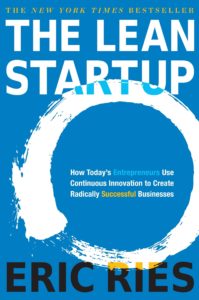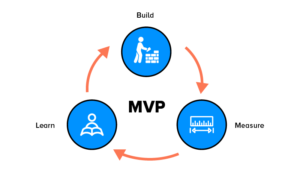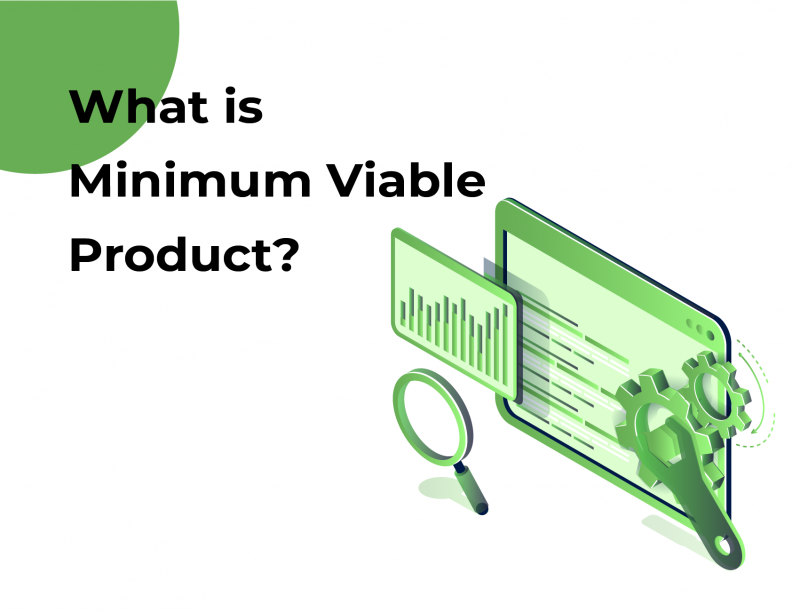Creating startups is a route full of experiments and challenges. There are lots of things you should come up with, from generating an outstanding idea to investing in marketing to deliver the product. This is the way that typically every startup follows.
However, many companies admit that building a product is not necessary in the first place. And you know what — this strategy works! If you want to replicate the success of Facebook, Alibaba, or Airbnb, you should get closer to creating a Minimum Viable Product. This post covers the most useful facts about the popular MVP approach.
What is MVP? Quick Definition
A minimum viable product (MVP) is a concept that has come from the Lean Startup philosophy; it highlights the impact of learning in new product development. This is about a version of a new product that lets teams collect the maximum amount of validated learning about customers with the least effort.
MVP became popular after Eric Ries described the concept in his book “The Lean Startup” (2009).

What is a key premise behind the MVP concept?
The supposition behind the idea of MVP is that you produce a relevant product that you can offer to clients and observe their actual behavior with the product or service. The very important thing here is to understand that seeing what consumers actually do with respect to a product is more reliable than asking them what they would do.
Let’s say, MVP stands for:
- Minimum: a basic set of product features.
- Viable: it provides value to customers, and they are ready to pay money.
- Product: it is ready to use now.
The Lean Startup concept teaches us that any startup creation process should start with the question: Do users need this particular product?
An MVP doesn’t aim to launch a startup for fewer resources or less money; instead, it’s about minimizing risks by focusing on customers, gaining feedback, and iterating on it. MVP is a concept designed from the ground up, which is later tested on the market to see if it has the potential for success. To pass through this testing, the product requires only essential functionality.
With the help of the MVP version, you can define the product’s potential. The method of the minimum viable product is applied widely to develop different products, including websites and mobile apps.
The meaning of the “viable” word
What is viability about in this context? Viability means delivering enough value to customers. In general, MVP development is characterized by ensuring the viability of the product.
According to practice, approximately 60 % of the functionality of an average product is not used at all. Unfortunately, this functionality looks like a waste of development resources. However, a viable product meets user demands.
The balance between “viable” and “minimum” is crucial to make sure you create a product that users will like and use.
By the way, this can be explained with the help of anything: a warm fresh croissant is a final product, but just shaped from the dough and ready for heat treatment is the prototype of this product.

What are the key benefits of MVP?
Minimum Viable Product will assist you in getting early data that will confirm your potential customers’ interest in your product. When the results of the MVP stage are positive, then you receive the green light to develop the full version.
Generating and testing an MVP will provide you with the following benefits:
- Saving resources and time by making sure you’re investing in a product that’s likely to be appreciated.
- Ability to analyze if the product is appealing to potential users.
- Identifying the trends you can apply.
- Attracting investors at an early stage.
- Aсquiring a potential user base.
- Saving time and money on developing the final product.
What are the potential pitfalls?
Often companies and teams apply the term MVP but do not understand its actual meaning and intended use. This lack of the MVP’s understanding typically leads to believing that they can deliver just the smallest amount of product functionality without additional criteria.
Sometimes people even confuse the minimum viable product that has a focus on learning with MMF (Minimum Marketable Feature) or MMP (Minimum Marketable Product) that are focused on earning.
Teams may deliver what they consider an MVP without further changes to that product, regardless of the feedback they receive about it.

What are the examples of companies that started from MVP?
Today there are many flourishing businesses that started from the MVP Agile approach, and you definitely know them:
- Foursquare
- Netflix
- Pebble
- WhatsApp, and many more.
Here are some details about their experiences:
- Initially, Facebook was a social network for a small number of users released to collect feedback. It actually began at Harvard University. Its version 1.0 included a profile page, friend requests, and the option of sending messages. Today we all know Facebook as a multifunctional social network with various features such as photo sharing, reactions, news feeds, events, ad management, live video, and many more. The difference is impressive.
- Foursquare is another company that has successfully applied the MVP principles of a minimum viable product. This social network is based on locations. It also began as just a single-feature MVP, offering just check-ins and gamification rewards. After the validation of the idea with a growing user base, the Foursquare team started to add more features, such as city guides and recommendations.
- Pebble is a well-known e-paper smartwatch brand. There were some troubles with investor funding in the company, so the founder turned to a crowdfunding campaign. He used a Kickstarter site and became the most successful project there, raising more than $10 million from the people desired to support development. He simply recorded an explanation video to demonstrate the prototype (MVP), asking interested customers to contribute.
- Twitter has the roots from the podcasting platform Odeo. After Apple released the podcasting game with iTunes, Odeo found the ground slipping away and decided to run hackathons to realize where to head next. One of the ideas was about sharing updates with a group of people and messaging, codenamed “twttr”. The first MVP was used by Odeo employees and gave the development team the push to release Twitter publicly.
How to Plan an MVP? The Step-by-Step Guide
There are some basic steps related to generating an MVP and discussing details about what happens at each phase. This process with these steps will enhance your skills related to how to define and prioritize features, and how to outline what you need to get your MVP.
1. Identifying global business needs
First, you need to identify the real need for your product in the market. This need can be organizational or individual. The analysis of the current state of competitors is also critical. It will assist you in exactly determining what product you need to be successful.
After defining the need for your product, you should set long-term business goals you are planning to achieve. At this stage, it’s also important to understand what will define the success of your product in particular.
2. Mapping out user journeys
Mapping out user journeys is an excellent way to ensure that your users will have a positive experience with your app’s first iteration. It typically allows looking at your product from the perspective of the user. This mapping reflects how you can design the app in a proper way for consumers.
Creating a user journey, consider the following things:
- Identify the user
- Identify the Actions (Jobs)
- Identify the Story ending
3. Adding a pain and gain map
The first experience with the user flow will probably lead to the desire to create the pain-and-gain map for every single action. This kind of map will let you identify all user pain points and the gains the user reaches when each pain is addressed. The approach allows defining where you have the greatest potential to add value.
4. Choosing proper features to build
Now you can discern which features to include in your MVP. Also, you are able to define what features to add to your product roadmap that has a lower priority.
There are some effective tools for deciding what features are necessary to make your MVP robust.
- Opportunity statements. They can be used to help you when finalizing what features you want to build.
- Breaking down features. This process will help you to choose and include proper features to the roadmap.
- Prioritizing features. With the help of powerful prioritization matrices, you will be able to identify where you can make the most impact on the urgency of the feature. The prioritization matrix will help you to make the final decision on what features to add in your MVP and which ones to include later.
What’s next?
After the MVP launch, it’s time to gather feedback. Your users will help you to identify where the product is lacking capabilities and ensure market validation. This feedback will let you generate new ideas based on user behavior research. Keep on learning, testing, and measuring until the product is finalized.
Conclusion
Creating a minimum viable product will surely help you in case you are planning to start something new. The most important fact is that, once you launch the MVP, you may gather useful feedback and make changes in your product where needed.
Hopefully, this post will help you through your business journey!





